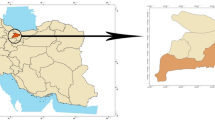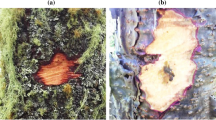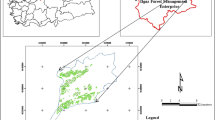Abstract
The objective of this study was to obtain neural networks that would precisely estimate inside-bark diameter (d ib ) and heartwood diameter (d h ) and compare to the results obtained by the Taper models. The databank was formed so as to eliminate inconsistent and biased data, and stratified: minimum d ib of 4, 6 and 8 cm and minimum d h of 10, 15 and 20 cm. The adjusted Taper model used was the Kozak model. For the fitting of artificial neural networks (ANN), tests were performed to identify the independent variables and the database scope level, i.e., the following input variables were tested: diameter at breast height (dbh), total height (H), height at diameter d ib or d h (h) and outside-bark diameter at h (d ob ), bark thickness at 1.3 m and project, and the scope at database level or project level. The estimates obtained by the neural networks and Kozak model were evaluated by residual graphs in function of the respective diameter observed and graph of the observed versus estimated values. ANN were found to be more efficient in estimating inside-bark and heartwood diameters for Tectona grandis trees than the Kozak model. The variables that must be used to fit the networks are dbh, H, h and d ob . Stratification by project results in precision gain, with precision being higher for wider commercial diameters. Thus, linear-type artificial neural networks can be efficient in describing the taper of Tectona grandis trees.




Similar content being viewed by others
References
Aleksander I, Morton H (1990) An introduction to neural computing. Chapman & Hall, London
Diamantopoulou MJ (2005) Artificial neural networks as an alternative tool in pine bark volume estimation. Comput Electron Agric 48:235–244
Görgens E (2006) Estimação do volume de árvores utilizando redes neurais artificiais. Dissertation, Universidade Federal de Viçosa
Haykin S (2001) Redes neurais: princípios e prática. Bookman, Porto Alegre
Kozak A, Munro DD, Smith JGH (1969) Taper functions and their applications in forest inventory. For Chron 45(4):278–283
Mehtätalo L, Maltamo M, Kangas A (2006) The use of quantile trees in the prediction of the diameter distribution of a stand. Silva Fennica 40(3):501–516
Oliveira LC, Angeli A, Stape JL (2007) Teca é a nova opção na indústria mundial. Rev da Madeira 106:81–86
Author information
Authors and Affiliations
Corresponding author
Additional information
Communicated by T. Seifert.
Rights and permissions
About this article
Cite this article
Leite, H.G., da Silva, M.L.M., Binoti, D.H.B. et al. Estimation of inside-bark diameter and heartwood diameter for Tectona grandis Linn. trees using artificial neural networks. Eur J Forest Res 130, 263–269 (2011). https://doi.org/10.1007/s10342-010-0427-7
Received:
Revised:
Accepted:
Published:
Issue Date:
DOI: https://doi.org/10.1007/s10342-010-0427-7




